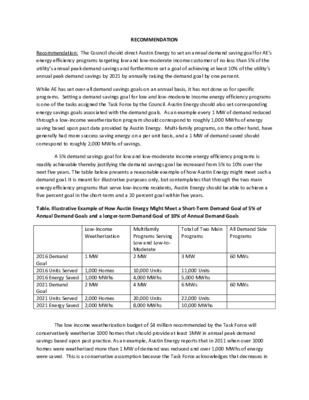Item 3b-Recommendation Regarding Low and Low-Moderate Income Energy Efficiency Programs Demand Savings Goal_Cyrus Reed — original pdf
Backup

RECOMMENDATION Recommendation: The Council should direct Austin Energy to set an annual demand saving goal for AE’s energy efficiency programs targeting low and low-moderate income customer of no less than 5% of the utility’s annual peak demand savings and furthermore set a goal of achieving at least 10% of the utility’s annual peak demand savings by 2021 by annually raising the demand goal by one percent. While AE has set over-all demand savings goals on an annual basis, it has not done so for specific programs. Setting a demand savings goal for low and low-moderate income energy efficiency programs is one of the tasks assigned the Task Force by the Council. Austin Energy should also set corresponding energy savings goals associated with the demand goals. As an example every 1 MW of demand reduced through a low-income weatherization program should correspond to roughly 1,000 MWhs of energy saving based upon past data provided by Austin Energy. Multi-family programs, on the other hand, have generally had more success saving energy on a per unit basis, and a 1 MW of demand saved should correspond to roughly 2,000 MWhs of savings. A 5% demand savings goal for low and low-moderate income energy efficiency programs is readily achievable thereby justifying the demand savings goal be increased from 5% to 10% over the next five years. The table below presents a reasonable example of how Austin Energy might meet such a demand goal. It is meant for illustrative purposes only, but contemplates that through the two main energy efficiency programs that serve low-income residents, Austin Energy should be able to achieve a five percent goal in the short-term and a 10 percent goal within five years. Table. Illustrative Example of How Austin Energy Might Meet a Short-Term Demand Goal of 5% of Annual Demand Goals and a longer-term Demand Goal of 10% of Annual Demand Goals Low-Income Weatherization Multifamily Programs Serving Low and Low-to-Moderate Total of Two Main Programs All Demand Side Programs 2016 Demand Goal 1 MW 2 MW 3 MW 60 MWs 2016 Units Served 1,000 Homes 10,000 Units 11,000 Units 2016 Energy Saved 1,000 MWhs 4,000 MWhs 5,000 MWhs 2021 Demand Goal 2 MW 4 MW 6 MWs 60 MWs 2021 Units Served 2,000 Homes 20,000 Units 22,000 Units 2021 Energy Saved 2,000 MWhs 8,000 MWhs 10,000 MWhs The low income weatherization budget of $4 million recommended by the Task Force will conservatively weatherize 1000 homes that should provide at least 1MW in annual peak demand savings based upon past practice. As an example, Austin Energy reports that in 2011 when over 1000 homes were weatherized more than 1 MW of demand was reduced and over 1,000 MWhs of energy were saved. This is a conservative assumption because the Task Force acknowledges that decreases in operating expenses are achievable as reflected in our recommendations for increased efficiencies such as leveraging the weatherization program with the City’s affordable housing programs and obtaining price discounts for program materials. Our leverage recommendation should decrease administrative costs and capture bill and demand saving arising from the house repairs done by the affordable housing programs. The Task Force believes AE can realize a 20% price discount on unit air conditioners resulting in the purchase of 100 air conditioners at the cost of eighty. The Task Force recognizes other leveraging opportunities are available. There are also discounting opportunities for other materials purchased for the low income weatherization program. The peak demand savings expected to be realized from the low income weatherization program are reasonable when balanced with the other policy objectives of the program such as equity to energy efficiency programs, reduction of AE’s bad debt and collection costs, healthier and safer residences, and reduced overall consumption of electricity that mitigates need for generation. The multi-family low and low-moderate income energy efficiency program should reasonably provide no less that 4 MW of peak demand savings based on the Task Force’s recommended budget with at least half of this dedicated to buildings serving low-income and low-to-moderate income residents. The sum of the peak demand saving for these two programs listed above meet the 5% recommended peak demand savings goal based on an annual peak demand reduction of 60MW. The other low and low-moderate income energy efficiency programs recommended in this report should only increase these peak demand savings. Consequently, increasing the peak demand saving goal at least 1% per year for the next five years to get to 10% is conservative and will encourage AE to operate more efficiently and to develop additional innovative low and low-moderate income energy efficiency programs.